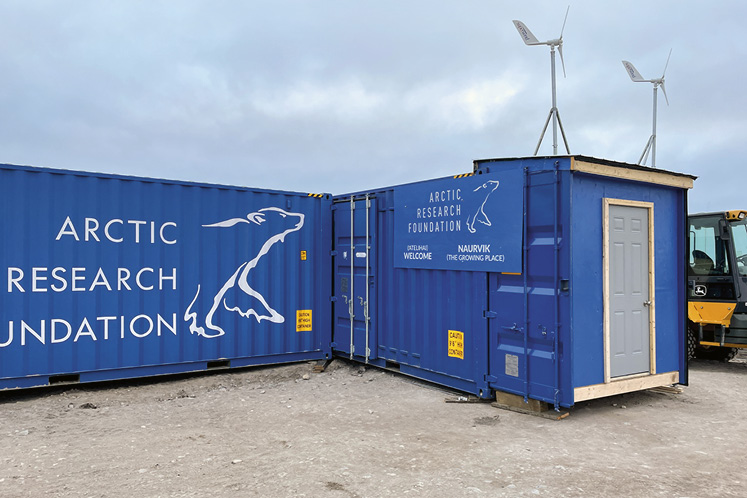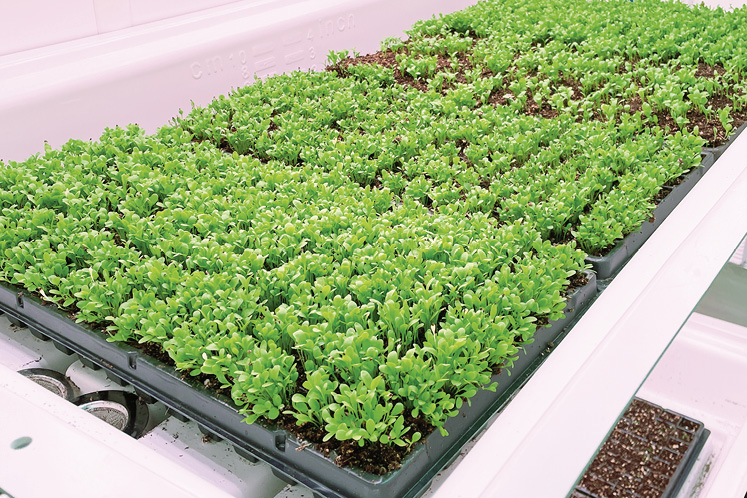Northern Connections – Tackling Food Security in Arctic Communities
Two Headwaters residents are working with Indigenous people on innovative programs to enhance food security in the Far North.
It’s hard to fathom any direct connection between the quaint villages of Headwaters nestled amid verdant rolling farmland and the remote Inuit communities along Canada’s vast and storied Northwest Passage. What could link our world of homegrown farm-to-table bounty with a seemingly barren tundra, struggling with some of the worst Indigenous food security issues in the developed world? You’d be surprised.
Two Headwaters locals have been helping plant the seeds of some bold collaborations linking these seemingly disparate worlds. And their efforts are helping empower First Peoples of the Canadian Arctic to transform the future of food security for their communities. Finding these solutions is not simple amid a tangle of the legacy of colonialism, the potential of modern technology, the cultural foundations of ancient ways of life, the unpredictability of climate change and more.
While 28-year-old Caledon East native Jordyn Stafford and 65-year-old Paul Waechter of Mono may be far apart in age and backgrounds, they share a passion for being part of these solutions. And their revelations about experiencing life in the Arctic are strikingly similar. Both say they’ve fallen in love with the people and landscapes of the Far North. Both say there is so much we can learn from these diverse Inuit communities. And both say we in Headwaters have far more in common, far more connections with the people of Nunavut and Nunavik than we may first think.
Here are their stories.
Paul Waechter: Technical Consultant, Arctic Research Foundation
It’s taken almost eight weeks from May to July of 2019, but the transformation of two basic steel shipping containers into high-tech greenhouses capable of operating off the grid year-round in Canada’s Arctic is complete. At the workshop behind his home, longtime Mono resident Paul Waechter has welded in the doors and windows then spray-insulated the floor. Next Travis Willoughby and Brandon Squirrel of Jamieson Construction in Shelburne framed and finished the interior. When the wiring was done, Paul painted the exterior bright royal blue, just before Craig Lush of Letter Rip Sign & Design in Mono came in to apply the Arctic Research Foundation logo. It’s a final, but important last touch. This ARF logo means a lot in the final destination of this new venture – a symbol of hard-won trust between two cultures together tackling some of the biggest challenges facing the people of the Far North.
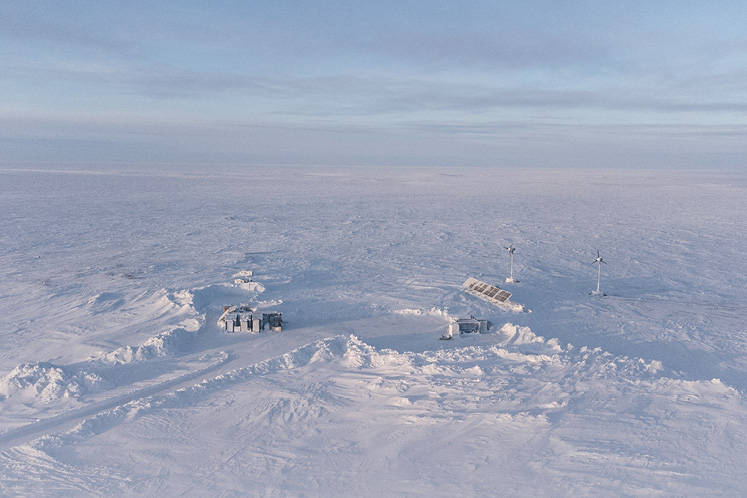
In frozen Gjoa Haven, a drone shot of the Naurvik complex belies the green bounty that grows within it. On the left are two growing containers, a utility container, a power lab and a lunch/meeting container. On the right is the Power Pod, consisting of inverters, controls for the wind turbines and solar array, along with batteries, a backup generator, and a work and repair container. Drone photo by Amber Bracken.
“You see so many great ideas and systems up there that have come from down south, but the ball gets dropped after the first, second, third year,” says Paul. “The systems just sit there and then it puts a bad taste in everybody’s mouth because people didn’t follow through on promises. So that’s a big part of our research – whatever ARF gets involved in, they follow through and work directly with the community.”
Co-founded by former co-CEO of Research in Motion Jim Balsillie, Arctic Research Foundation is a private, nonprofit organization with unique scientific infrastructure in the Canadian Arctic – cutting-edge research vessels and self-powered mobile labs. They partner with governments, universities and other research institutions, but their primary focus is Indigenous community-led projects that advance understanding of the region with technology developed in concert with traditional knowledge and values. This priority underpins the enduring trust ARF has built with their Inuit partners.
A self-described “energy guy,” Paul was hired by ARF CEO Adrian Shimnowski in 2009 to help design and produce the innovative off-the-grid mobile lab projects that Adrian had conceptualized. Since then the two men have worked hand in hand, sharing a deep commitment to bringing the projects to fruition.
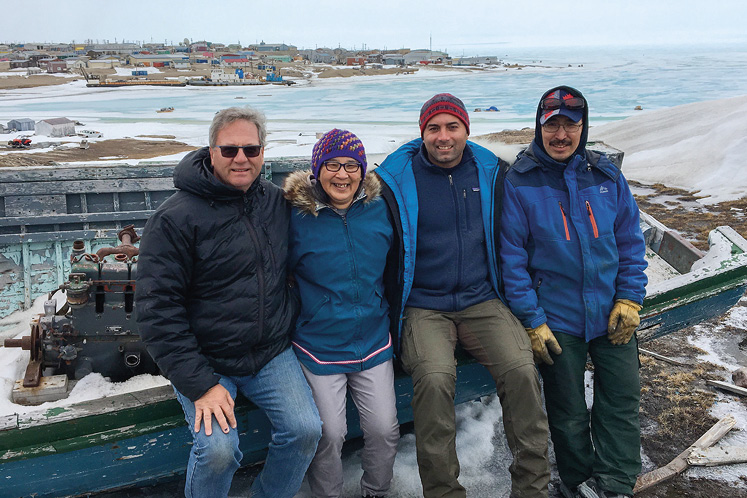
On the shore outside Gjoa Haven: Paul Waechter, Betty Kogvik, Adrian Schimnowski and Sammy Kogvik. Gjoa Haven photos courtesy Paul Waechter.
Indeed, the pair were deploying container labs in the Arctic when ARF ships and search teams, with the help of Gjoa Haven locals, found the two wrecks of the fabled Franklin Expedition, HMS Erebus and HMS Terror. In 2016, it was Sammy Kogvik, now a trusted colleague on the greenhouse project, who shared his memory of a wooden pole sticking out of the ice and led Adrian and his crew to the location where the Terror was discovered.
Asked by ARF what they could do in gratitude for the community’s assistance with the find, the elders named opportunities for youth and food security as their priorities. The two grow pods – eventually dubbed Naurvik, meaning “the growing place” – were the result, opening the door to an entirely different and deeper way of working with the community for Paul and his colleagues.
The Journey to Gjoa Haven
By the third week of July 2019, the containers arrive at Port of Valleyfield, near Montreal on the St. Lawrence River. In the next six weeks, his two special “sea cans” will sail out to the Atlantic, up the coast of Labrador, across the top of Hudson’s Bay and through the Northwest Passage to the hamlet of Gjoa Haven on King William Island, about 250 kilometres above the Arctic Circle. Paul will meet them there, settling into the hamlet of about 1,300 residents. He and his local team will have just three weeks to set up a row of solar panels and two wind turbines, the most northerly in Canada. A diesel generator will serve as backup when the wind and sun fall short. They’ll do all this just before the first winter blizzard hits Gjoa Haven on October 1 that year. Of course, no one could imagine the storm of global upheaval that would begin just months later. And all of this would have been delayed years by the pandemic, if Paul and the rest of the ARF team weren’t racing to beat that Arctic ice near the end of 2019.
Locals such as Sammy Kogvik, who now manages the site and power systems, and his wife, Betty, who manages food growing and distribution, are the guardians of these budding fruits and vegetables, growing safely inside the blue containers on a hill near a bay just out of town, in a place that elders insist would get a lot of wind.
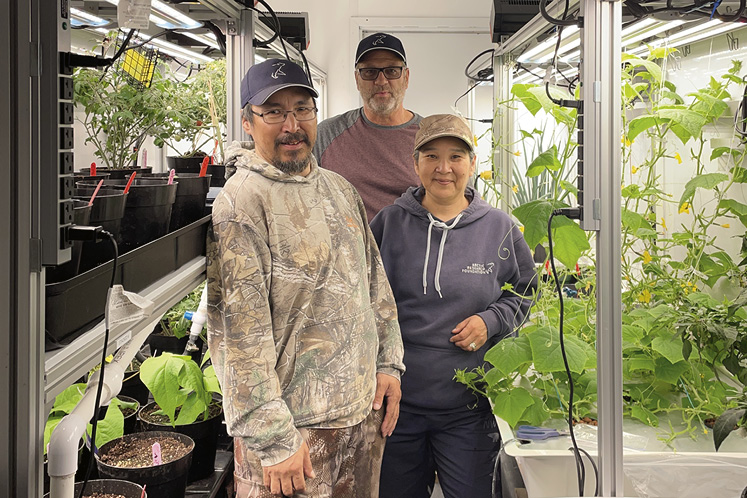
Paul Waechter (rear) with Betty and Sammy Kogvik in the warm light of a grow container. Gjoa Haven photos courtesy Paul Waechter.
In a 2020 interview with CBC, Betty commented, “At the beginning, it was really confusing.” The Inuit are not traditionally farmers. “We didn’t know what to do, but we’ve got the hang of it now.” Since that time, Sammy and crew have kept the systems running. Trainers have been brought in to teach basic carpentry, plumbing and electrical skills for locals working on the project. Gjoa Haven schools have arranged field trips for the next generation to learn about the operation and its potential.
These ARF greenhouses have been backed by Agriculture and Agri-Food Canada, the National Research Council of Canada, and even the Canadian Space Agency – it wanted insight into how astronauts might grow fresh food in inhospitable conditions. Still, as Paul explained, the primary focus has always been making this venture sustainable with and for this Inuit community.
“The Inuit have a philosophy of living off the land. And ‘country food’ is a very important source of their diet. When it’s the season – for caribou, muskoxen, seal – many guys will pretty much drop everything and go hunting. So early on, that was a challenge when we created these systems that needed to be monitored daily,” he says. “But in the past few years, it’s interesting how our cultures have learned to mesh and make things work.”
Describing himself as a “get it done” person, Paul says, “If it needs to be done, it needs to be done now.” But the ways of the Inuit in Gjoa Haven have changed him. “They’ll be off hunting and something in the system may have broken down. I’d be up all night working on it. But they’ll arrive the next morning when they’re back. It’s going to be 30 degrees in there instead of 70. But they just take it in great stride. And over the years, they’ve been right – the system keeps running as it should, eventually. So it seems I am the one that has had to adjust.”
Produce such as cherry tomatoes, strawberries, various lettuces and the like have been grown and harvested about every two weeks, and then given to the elders for distribution. “Produce is expensive and often past it’s best-before date before even reaching the shelves here,” says Paul. If scaled up, this high-quality, fresh local produce could help reduce grocery prices, often 10 times that of the rest of Canada. “That’s the next phase we’re working on, expansion of production,” explains Paul.
Beyond scaling up production, community members are also shaping the future of how this test facility is used. The community is looking at growing local cloudberries, blueberries and other tundra plants used for medicines and tea. “The teas they hope to market and sell far away from Gjoa Haven,” says Paul. “So they’ll be creating income that may help make the whole venture more sustainable.”
When asked on a recent trip home to Mono what he’d like his neighbours in Headwaters to understand about his experience of this northern world, he took a few moments to ponder before answering.
“It’s kind of cool to think of these things going to some incredibly remote place,” Paul says, pointing to the new containers behind his workshop where Travis and Brandon are working. “And it’s exciting that people in Dufferin County are doing this. The guys here are pretty excited to be part of it, maybe even making some difference.” He pauses, then continues. “I guess too, I always thought the Arctic was so far away, unreachable and I was even apprehensive about going at first. But since those first containers that we took up years ago, I think the most important thing is the connection I’ve felt with the people and their sense of community. They become your friends and we all rely on each other. Everything there is about community.”
Jordyn Stafford: Nunavik Food Security Manager
Communications in the far north can be tricky, but thanks to her grandmother Bonnie Ledson in Caledon, I finally connect with Jordyn Stafford. She connects with me from the northern Inuit community of Inukjuak. With a population of about 1,800, it’s located on Hudson’s Bay at the mouth of the Innuksuak River in Nunavik, northern Quebec – almost 1,500 kilometres north of Montreal. And while our internet connection is at times tenuous, her passion for the North rings through loud and clear.
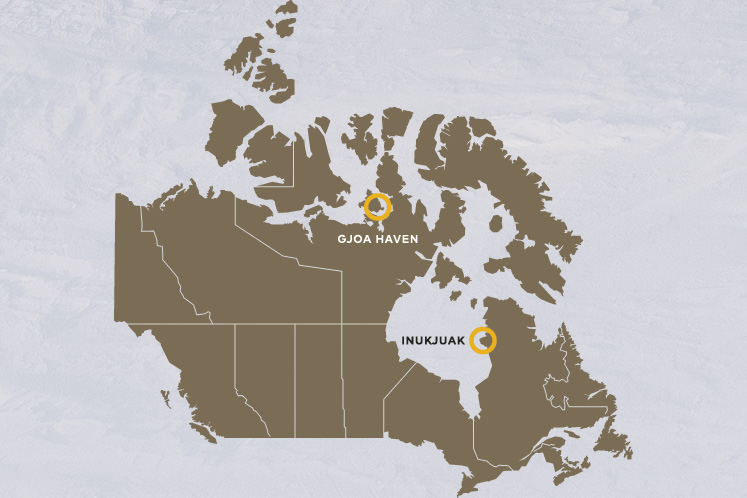
A map showing the location of Inukjuak, where Jordyn works, and Gjoa Haven, location of the ARF grow pods.
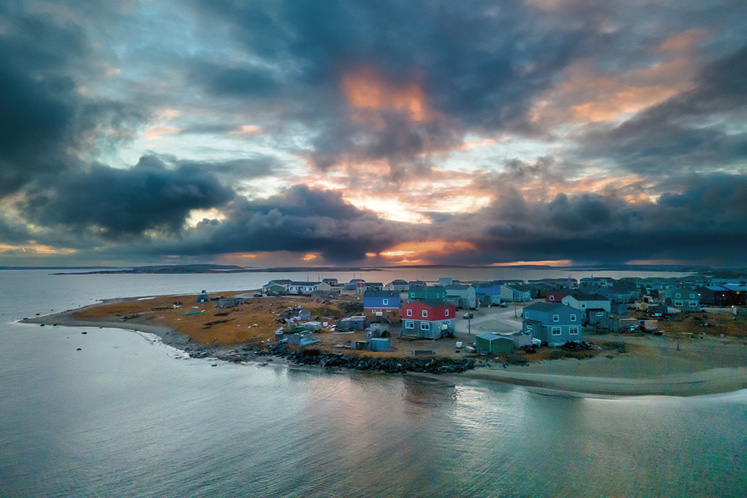
The community of Inukjuak is located on Hudson’s Bay in Nunavik, northern Quebec, 1,500 kilometres north of Montreal. Drone photo by Syvain Paradis.
Reflecting on her recent return to Inukjuak just days before our chat, Jordyn says, “I think there’s something about the vastness here that puts your life into perspective. It makes you feel small, but in a wonderful way. As soon as I was done work that first day, I took my four-wheeler and drove onto the land to pick berries. And I was overjoyed, jumping up and down. It was so liberating. So freeing, this expanse of nature. It makes you feel alive in a completely different way.”
But as the Caledon East native elaborates, the harsh beauty of the Nunavik tundra means even more. “There is something in knowing how remote each community is here – the need to fly or undertake a very long Skidoo journey or boat ride to go from one village to the other. Your sense of community here becomes that much stronger when you know you need each other. It’s very profound.”
Readers of this magazine may remember Jordyn from her 2018 profile as one of Headwaters “25 under 25,” which celebrated the achievements of local young people. At the time, she was not long out of school, and only one year into her move to Nunavik, working as a youth program co-ordinator.
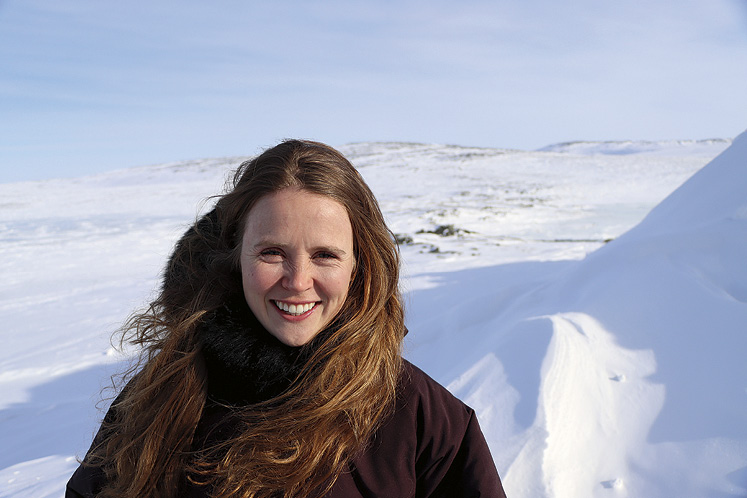
Raised in Caledon, Jordyn Stafford now oversees the food security programs for Nunavik Regional Board of Health and Social Services. Photo by Jordyn Stafford.
“I studied environmental science and sustainability at university, and was always fascinated by the intersection between the environment and food,” says Jordyn. She admits to having only a passing knowledge of Canada’s North at the time, but the experiences of a few peers sparked an interest. “I’d had the privilege of travelling all over the world, but felt I didn’t know what was going on in my own backyard.”
After a brief but transformative experience as a literacy counsellor in Northern Labrador, she jumped at the opportunity to go to Nunavik. Now five years later, Jordyn oversees the all food security programs for Nunavik Regional Board of Health and Social Services. It’s a big job.
“Food insecurity impacts eight in ten people in this region. It’s the highest rate of food insecurity among an Indigenous population in the developed world,” she says. But like Paul’s work with ARF, Jordyn and her Innu colleagues follow the lead of locals. “We support communities in solutions that work for them. They are the experts and we support their local projects.”
For example, this day she’s working at Sirivik, a locally-run food centre that takes a holistic approach to tackle food security from several angles. The centre provides a drop-in table where people in need of urgent food aid can come for breakfast or coffee; a skills building program for hunting and harvesting on the land – to help reduce dependence on expensive food imported from the south; and a community kitchen that offers cooking classes and more.
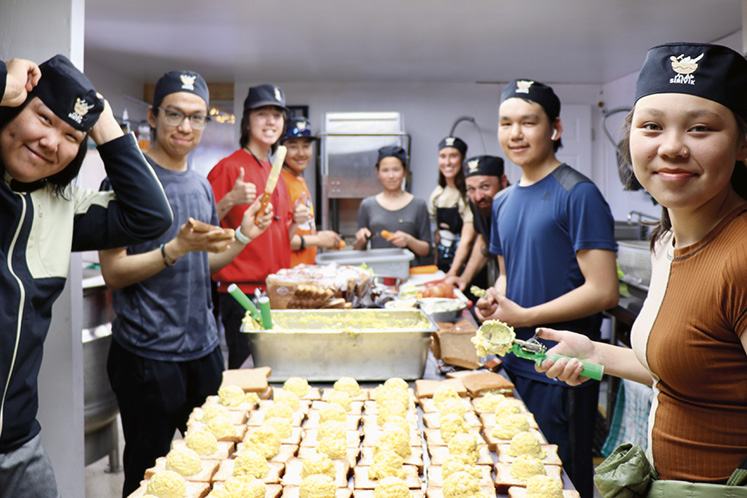
Staff and volunteers at Sirivik, a locally run food centre, make picnic lunches as part of a youth-led
healthy lifestyle program.
In other communities Jordyn’s program supports community pantries or food box initiatives. “In each case,” she says, “the focus is trying to find a balance between addressing the immediate unique needs of each community and finding long-term solutions.”
As Jordyn describes it, there are many factors contributing to this crisis. There’s the legacy of colonialism disconnecting many Indigenous people from traditional ways of life across this country. There’s the technology of the modern world that’s changed what life looks like even in these remote communities. Climate change is another huge factor.
“We’re seeing an on-the-ground shift in the range of species, which profoundly affects how the community hunts and harvests their ‘country food.’” Arctic char, for example, is beloved here. However, as beavers move further north, they’re damming rivers that the char would normally navigate. The char aren’t spawning in the same places. Black bears are appearing where they’ve never been before. “We try to find ways to support traditional species faced with this additional pressure,” Jordyn says, “but we’re also collaborating with Indigenous communities farther south to learn more about how these new species can be hunted and harvested.”
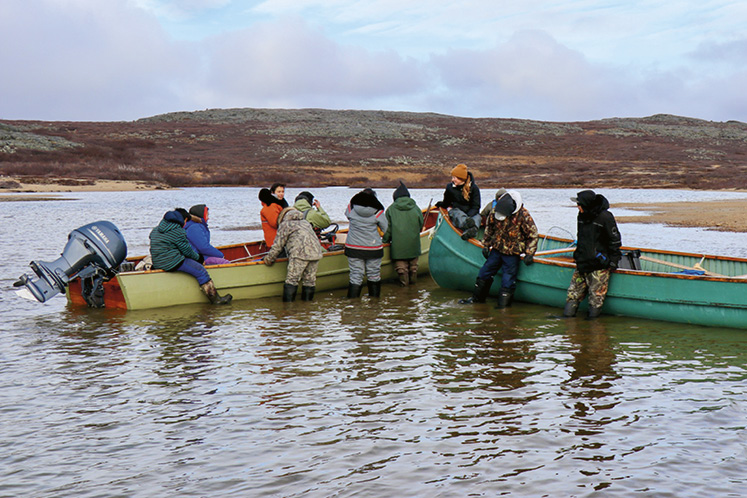
Jordyn Stafford (in the gold tuque) participated in a Sirivik-sponsored outing “on the land” where youth learned from local hunters to harvest mussels, sea urchins, ptarmigan and ducks. The harvest was shared by the community.
Jordyn notes there is also far more risk with climate change – the spring comes earlier, the ice freezes later. There’s a smaller window to go out on the land. “And the weather is far less steady, so there’s more danger when people do go,” she explains. “We’re looking at ways to increase safety – access to emergency shelters, ice breaks and more search-and-rescue vehicles. People here can no longer rely on traditional knowledge alone to keep them safe because the environment is changing so quickly.”
Despite these challenges, Jordyn says local interest and passion for the land, for people to eat “country food,” hasn’t changed. “Holding a job, raising a family and also being able to go on the land and participate in the education of the descendants – it’s tricky to manage all those things at once,” she says. “But it’s definitely still a priority across all the communities here.”
Like Paul and the ARF approach, Jordyn has seen firsthand how powerful it can be to mobilize local people around an idea. For example, Nunavik communities are also experimenting with hydroponic vegetables and, like the Gjoa Haven project, they are making it their own.
“There’s an Inuit grocer in Inukjuak with a hydroponic container growing typically southern produce alongside a local species of mountain sorrel with a lovely citrus flavour,” she says. “It’s something people here love and have harvested for many decades. So when you combine interesting new technology with traditional food systems, you have a synergy and a solution that’s going to make a difference.”
Lessons from the Far North
Jordyn has a busy day ahead. It’s time to log off our chat. But as I did with Paul, I have to ask this born-and-bred Caledon girl one last question. “What do you think your friends and neighbours back home should understand about what you’re doing there, about the land and people? Why should they care?”
“Good question,” she says, tipping back her head back, then looking again into the camera. “You know, we’re all human. We all have the same needs, the same wants. I’ve learned so much here. Perhaps most important, we need to have compassion for other communities, and by supporting each other we’re able to build a more beautiful, vibrant society.”
She continues, “This place may seem far away. But it really isn’t. I see so many parallels between Inukjuak and Caledon. Both possess a deep sense of community. Both have a passion for the beauty of the nature that surrounds them. And maybe the hills of Headwaters don’t look like the tundra of Nunavik. But in both places, the desire to engage with and support our neighbours. It’s really the same thing in a different place. We’re not that far apart at all.”
From the shores of Hudson’s Bay in Nunavik, Northern Quebec – words to live by indeed.
Related Stories
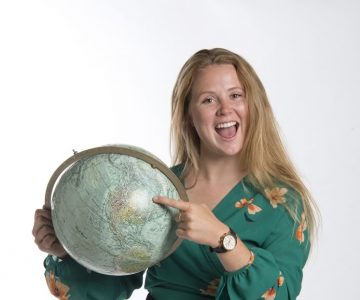
Northern Booster: Jordyn Stafford
Nov 20, 2018 | | 25 Under 25Caledon East’s Jordyn Stafford lives and works as a youth counsellor in the remote community of Inukjuak in northern Quebec.

Water Security – Tin Roof Global
Jun 20, 2016 | | Back IssuesA Creemore charity works to ensure clean water security for First Nation communities
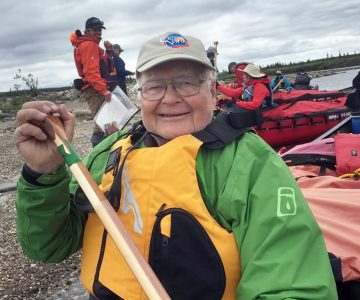
John Wheelwright
Nov 20, 2018 | | Over the Next HillJohn Wheelwright, 89, paddled 300 kilometres on the Upper Horton River north of the Arctic Circle this past summer.
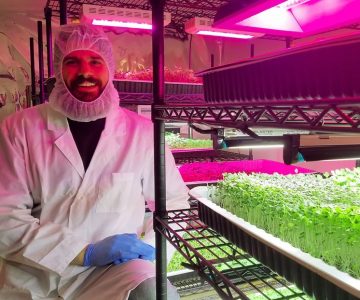
Microgreens Go Macro
Mar 24, 2020 | | FarmingHow local growers are tapping a surging demand for the tiny, tasty stems that pack a nutritional punch.

